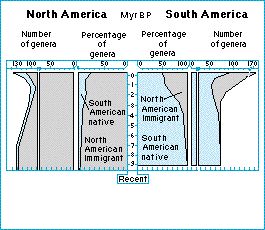Evolutionary biogeography - What happens when two continents collide?

Why did the North American mammals prove superior?
The increase in number of originally North American genera can be seen across a wide range of mammal types, which suggests they had some general advantage. There are several ideas why. One is that the North American mammals had lived a more competitive life, in a larger continent with more species, than the isolated southern mammals. The 'arms race' of competition had moved further in the North. Arguably, when the North American mammals invaded the South they had been prepared by 50 million years or so of more demanding competition. They possessed advanced armaments, probably not only in intelligence, that enabled them to over-run the southern mammals.
Alternatively, as Marshall and his co-authors suggest, the North American mammals may have enjoyed some advantage in the environmental change of the past 3 million years. The Andean upthrust sheltered the Americas from the Pacific, creating a rain shadow east of the mountains. In South America, dryer pampas or even semi-desert replaced the moist savannah and forest. Quite why such a change should benefit the North American mammals at the expense of the South American forms is unclear; but such a change would be likely to benefit one of the two groups more than the other. It was a large change, and was therefore probably influential in the faunal replacements of the time.
Figure: numbers and percentages of genera of land mammals in the last 9 million years in North and South America. Note the wave of immigration after about 3 million years ago. From Marshall et al (1982).
| Next |



